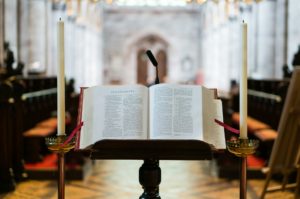Situated on the River Elbe, approximately midway between modern day Leipzig and Berlin, sits the town of Wittenberg. If you visit this town of 50,000 people today, your tour guide will doubtless want to take you to Market Square and show you the Stadtkirche (Town Church). This church, which dates to the 13th century, could hardly be more pivotal in what we now call the Protestant Reformation, and in some of the worship reforms it brought.
Imagine yourself seated in this church on a Sunday morning in 1517. As a faithful member of the Church, you take your place in one of the drafty pews as the service is just beginning. While Wittenberg can’t quite boast the wealth of musical talents of a large cathedral like the one in Erfurt (where Martin Luther was ordained in 1507), nonetheless you settle in to hear some wonderful music coming from a majestic pipe organ. After the strains of the organ fade into silence, the choir—composed of boys and men—begin to sing a motet composed by French composer Guillaume de Machaut. Once again, you are transported by the sumptuous melodic lines, and the sheer beauty of the sound.
But perhaps your mind has already begun to wander. Though the musical offering from the choir is beautiful, the Latin text is completely unintelligible to you. Though you have the privilege of being literate (unlike many of your neighbors), your linguistic repertoire doesn’t extend beyond your native German. Becoming quickly distracted from what is happening in the front of the church, your mind wanders into thoughts of the everyday: how will I earn enough to keep body and soul together another month? Will my children stay healthy? And a million other things.
Now the priest has taken up his post and is beginning to intone the first words of the mass. But still, the language is Latin, and thus you give up any hope of connecting with its meaning. If you’re like some, you will have brought your own aids to private devotion with you, and as the words from the front of the church continue to wash over you, you begin to give attention to your own private prayer and contemplation.
This little thought experiment describes a situation that would not have been unusual at the turn of the 16th century. Worship in the typical church of that time had become increasingly clergy-centered. Most of the worship “action” took place at the altar, and some of it was even performed by a priest who had his back turned to the congregation. Music was also professional, in the sense that it often did not involve the congregant (though there is some disagreement as to just how much the congregation of that time may have been integrated in singing).
It was into this scene that the reformer Martin Luther stepped. Having stirred up the waters with his posting of the 95 Theses on the door of the Castle Church in 1517, Luther became increasingly a man on the run. He took refuge at the Wartburg castle in 1521 after a daring (and may we say, quite creative!) “friendly kidnapping” (if you don’t know that story, do read about it!). While in self-exile, he devoted himself to writing on a grand scale. Among his work at Wartburg was the translation of the entire New Testament from Greek into German—and all of this in the space of 11 weeks! But in 1522, Luther returned to Wittenberg, and began to preach at the Stadtkirche.
Here is where Luther began to provide much needed reforms in the church—not just theological reforms, but methodological reforms as well. Luther seems to have had a keen awareness of what people needed in their everyday relationship to God. He was aware of how isolated the Christian can become if not included in the liturgy of the worship service. Luther himself was a good musician, and loved music dearly. He once said: “Next to theology I give to music the highest place and honor.” And so, Luther began to incorporate German hymns into the worship services at Wittenberg. During the years 1523-24, Luther wrote some 24 hymns (over the span of his life, he wrote 37 hymns).
It is perhaps difficult for us to grasp the significance of this development in the liturgy of the church. Despite our differences of opinion as to musical style in a worship service, we almost never encounter a situation where we can’t understand the text of a song, or worse yet, a situation where we aren’t at least invited to sing. But this was precisely the situation that Luther took on, and he did something about it!
There is so much to say about this pivotal moment in church history! But let me conclude by suggesting a few things for which we ought to be grateful to Dr. Luther:
1) The song of the Church belongs to the people of God. The Psalmist said, “He (God) has put a new song in my mouth.” What a pity for God’s redeemed people if they don’t take up that song themselves, not leaving it to the “professionals.”
2) Luther’s hymns (look at some of them sometime!) are all about teaching us theology. Luther once said, “God has His gospel preached through music, too.” We need to remember that, in addition to being a vehicle for praise to God, our congregational singing is meant to “teach and admonish one another” (Col. 3:16).
3) Luther laid the groundwork for those who would come after him. As just one example, but a monumental one, consider the Baroque composer Johann Sebastian Bach. Bach is perhaps the example par excellence of a musician who gave himself in the life of the church. Bach drew extensively on the heritage of Luther and the Lutheran church in writing his music for each Sunday of the church. Some have called Bach a “musical preacher” because of his concern for communicating God’s Word in music.
The next time you stand to sing a hymn, listen to all of your brothers and sisters’ voices around you, take in the great theology you’re singing (in your native tongue!), and be grateful to God and to Martin Luther!
Greg Wheatley, Director of Music at New Covenant Church, Naperville





